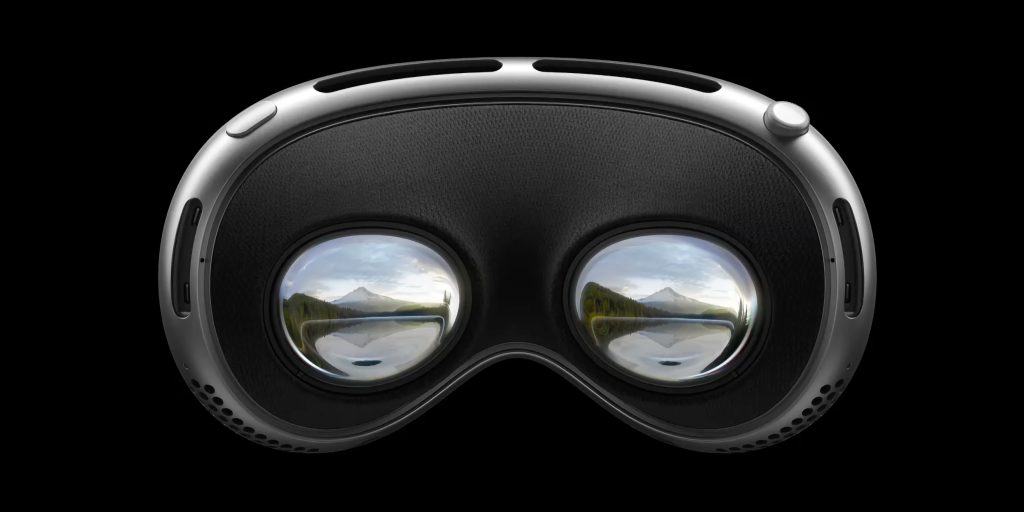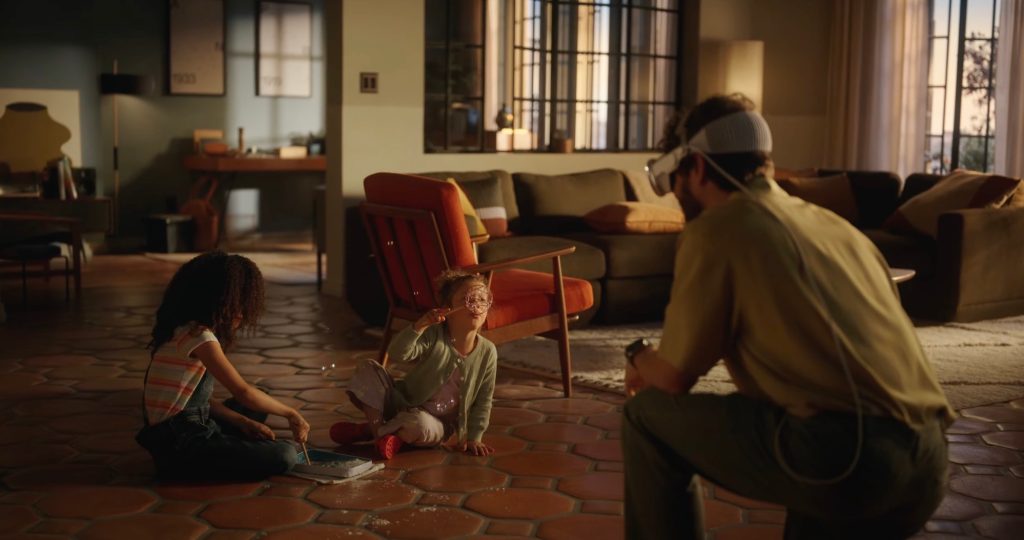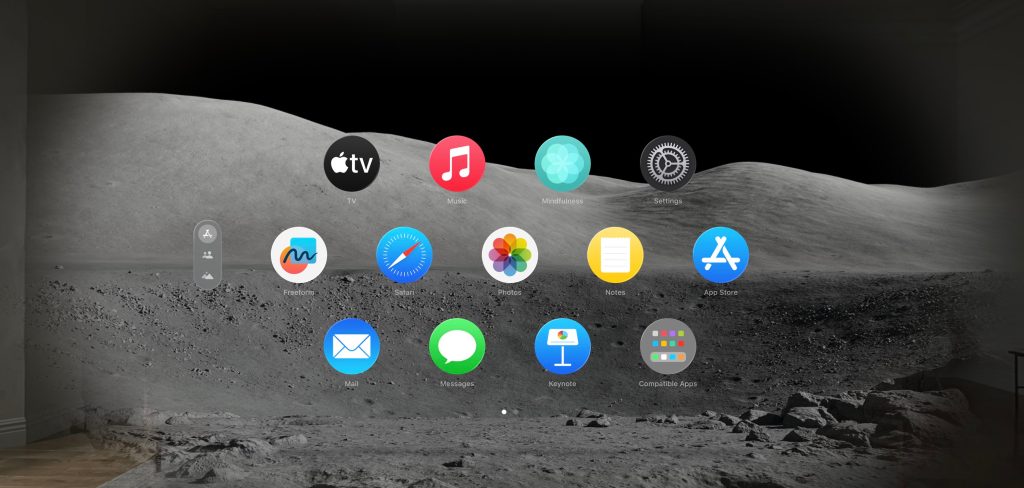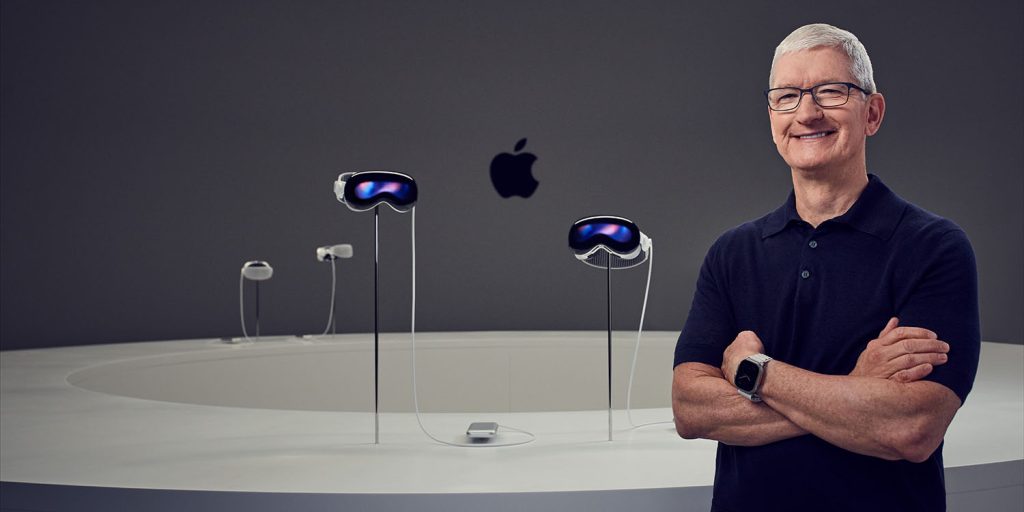
I had the chance to try Apple’s new Vision Pro spatial computer at WWDC last week, and I quickly published my first impressions that same day. Over the past week, I’ve had a lot of time to reflect on the experience and read first impressions from a number of other sources.
How have my thoughts changed? Not really… and I think that says a lot about just how impressive Vision Pro is.
Table of contents
Vision Pro demo inside baseball
I was lucky enough to be one of the first five to 10 people in the press to try out Vision Pro. After the WWDC keynote, I went to Steve Jobs Theater, where I snapped some very quick pictures and video of the new 15-inch MacBook Air. After just 15 minutes at Steve Jobs Theater, I met my Apple PR contact, and we took a golf cart ride across campus.
At this point, I still had no idea where exactly I was being taken and what was going to happen next. I knew I had an Apple briefing, but a briefing for what? The new Mac announcements? iOS 17 features?
But toward the end of that golf cart ride, Apple’s special “Field House” demo area at Apple Park came into view, and I knew that I was about to see Vision Pro. Little did I know I’d also try it on and get the full experience of using the headset and visionOS.
One thing I neglected to mention in my initial hands-on post was the process of the demo itself. The demo occurred in a private room at the Field House with me and two Apple representatives. There were demo units available to look at inside Steve Jobs Theater and in the common area of the Field House, but (with the exception of Robin Roberts) all demos occurred in private, and pictures and videos were not allowed.

Because I was so early in the hands-on briefing schedule, I left the Field House in my own little bubble. I hadn’t spoken to anyone else about my first impressions or about their first impressions. I was blown away by the Apple Vision demo, but were my thoughts clouded by the general excitement of being at Apple Park and the associated adrenaline rush? Even as a member of the press, it’s hard not to get swept up in the moment.
I actually found this siloed experience to be beneficial to my initial hands-on Vision Pro story. My thoughts weren’t clouded by knowing what other members of the press thought. I was off in my own world, and I could write my thoughts based solely on my experience with the headset.
And after I published my story and others started to publish theirs, it was clear I wasn’t alone in walking away, stunned by what I had experienced.
This is one of the reasons I wrote my story immediately after my Vision Pro demo. I left the Field House, hopped on a golf cart for a ride back to the Apple Park Visitor Center, got in my rental car, and drove back to the hotel to start writing. I didn’t want to see anyone else’s first impressions before I had written and published my own. I was so focused on writing that I had lunch from Lazy Dog delivered to the hotel through DoorDash and made Zac pick it up in the lobby and bring it to my room. I ate half my burger and left the french fries untouched. I did, however, demolish the Diet Coke.
Anyway, I could have waited to publish my story until I had time for my thoughts to fully cement and develop, but I felt I had an obligation to publish something as soon as possible. After all, I was one of the few people who had tried Vision Pro at that point. My plan all along was to publish that story and do a follow-up after a week or so, which is what this story is.

When I talked to Federico Viticci from MacStories later that week, he also echoed the benefits of writing stories like this in a silo. Viticci published his full hands-on today, and it’s just as beautifully written as everything he writes.
After publishing my story on Monday night, I headed back to Apple Park, where I recorded a special episode of 9to5Mac Daily with Zac live from Apple’s special on-campus podcast studio. When we sat down to record, I realized I had largely forgotten Apple’s other announcements that day. Luckily, Zac had prepped some notes.
Why 9to5Mac?
One thing I’ve been asking myself since last week is why 9to5Mac was included in that very first set of Vision Pro briefings. I have a good relationship with Apple PR, but to try out Vision Pro at the same time as some of the biggest publications and YouTubers in the world was a surprise. There were further sets of briefings later in the day on Monday and on Tuesday.
My assumption is that Apple realizes it needs to reach as wide of an audience as possible, and 9to5Mac is part of that audience. We reach a much different audience than other publications, and Apple seems keen on including our audience in as much Vision Pro coverage as possible.
I’m very intrigued to see how Apple’s strategies ebb and flow over the coming months in the lead-up to Vision Pro’s release in early 2024.
The keynote and announcement
One thing I want to point out upon further reflection is that I think Apple largely nailed the initial announcement of Vision Pro. The keynote video did a great job of showcasing all of the different use cases and features of the headset itself and visionOS. I think Apple learned a lot from the announcement of the Apple Watch, which felt cluttered and rushed.
Part of this is also due to the fact that Apple has more time to refine and perfect its keynotes now that they are prerecorded and not live. There are no live demos that can fail, presenters can’t misspeak and stumble over their words, and Apple can clearly craft a movie-style narrative.
While there might not be a clear story on who this first version of Vision Pro is for, Apple’s keynote unveiling did a superb job of showing the potential of this technology going into the future.

If there was one moment that fell flat and was the subject of quite a bit of mockery, it’s this shot of the dad wearing Vision Pro to record spatial video and take photos. I get what Apple was going for when it decided to include that, but it stood out as a major “uncanny valley” moment in an otherwise excellent keynote.
Presumably, there’s more coming here at some point in the future. Maybe an upcoming iPhone model will let you shoot spatial videos and photos. Maybe Apple has some impressive machine learning technology that will be able to convert normal videos and photos to spatial format. Either way, I don’t think we’ve heard the full story here just yet.
I rewatched the keynote one more time with my wife yesterday. She was equally as impressed, but two things stuck out to her as someone not immersed in the Apple universe: the Persona feature for FaceTime and the EyeSight feature.
She explained that when she FaceTimes with someone, she wants to see their “real face,” and she wants the other person to see her “real face.” This is a fair criticism and one that I generally agree with.
I don’t know of a solution to this problem, and in fact, it might be an unsolvable problem. In the meantime, Apple can work to make the Persona even more lifelike and realistic because, as I pointed out last week, it still has a ways to go before it’s perfect.
Highs and one low
As I’ve thought more about the various demos I saw in my time with Vision Pro, a few things have stood out.
The FaceTime experience – in its current form – was the least impressive. I can absolutely see a use case for productivity and collaboration, but for person-to-person communication between friends and family, I don’t think the current implementation works.
This is largely due to what I mentioned above about the Persona, but there’s also a lack of flexibility when using FaceTime via Vision Pro. You can’t move the camera around to show different things, you can’t flip the camera to show off something around you – like your dog or someone else in the room with you.

But that was the singular low point of my Vision Pro demo. I can’t stop thinking about the other things I got to experience. Apple Immersive Demos transported me into a world of 180-degree 8K video. Imagine Apple TV 4K screen savers, but fully immersive from a first-person point of view.
This sounds creepy, but I also can’t stop thinking about the kid’s birthday party I got to relive using spatial videos. I don’t know who those kids were, but I hope they invite me to next year’s birthday party.
But what stands out most to me a week later are the sports and music videos I got to watch using Vision Pro. That clip of the Suns-Nuggets basketball game has been playing in a loop in my head since last week, as has the clip from the Boston Red Sox game that was shot from Boston’s dugout.
Finally, as a music fanatic, there’s the Alicia Keys video I got experience in immersive virtual reality. I could look to my left and see Alicia Keys playing the piano and look around the rest of the room to see her bandmates playing right along with her. I can’t stop thinking about this and daydreaming about the same experience with other artists.
The other things I tried during my demo were also impressive: Environments, movies (both 2D and 3D), mindfulness, multitasking, and more.
On isolation and loneliness
Earlier today, Zac published a piece detailing his concerns about how Vision Pro might exacerbate the feelings of isolation and loneliness that current technology has already perpetuated. While I agree that these are questions that need to be addressed by each Vision Pro user, I think there’s more to the story.
My belief is that Apple doesn’t want you to use Vision Pro as a replacement for in-person experiences and interactions. Its goal is that Vision Pro will be used to expand your interactions with other people and events.

Personally, I would never choose to watch a concert via Vision Pro if I also had the choice of going to that same concert in-person. But I would absolutely use Vision Pro to watch concerts I wouldn’t otherwise have the ability to see. I would also use it to rewatch and relive concerts that I’d seen in person but wanted to experience again.
Alternatively, look at the productivity example. Vision Pro can open the door to far more immersive collaboration than currently available if you’re a remote worker. Maybe you’re traveling, but the rest of your team is back at the office. You can join in via Vision Pro and be fully immersed in that experience.
What Vision Pro can do is give you the ability to experience things that you otherwise wouldn’t be able to experience.
The world has evolved a lot since the first iPhone was introduced. There are robust features for managing and limiting things like screen time, which weren’t available for the first 11 versions of iOS. As a society, we know more about how to handle technology now than we did in 2007. It’ll be up to each user to set those limits.
TikTok memes and “real” people

Vision Pro is already having a viral “moment” on TikTok, where users are faking a VR world to imagine themselves watching some of their favorite content – and jokingly watching some of the most iconic memes.
To me, this shows how much interest there is in Vision Pro. I’m particularly fond of the video showing off watching Taylor Swift’s Eras tour using Vision Pro. Something like that would be enough to push a lot of people over the edge when deciding whether or not to buy.
Here are some links:
- Taylor Swift’s Eras tour
- L to the OG
- Pitch Perfect
- Harry Styles yelling at you
- On a date with Harry Styles
- Step Brothers
- Flavortown
- Jellyfish Rave
- Suits
- Alice in Chains
- The Denny’s Grand Slam
- Jersey Shore
- Dance Moms
- Gossip Girl
- Lana Del Rey
- Abba
- Dave Matthews Band
- One Direction
- Ted Lasso
Q&A
- The Vision Pro displays run at 90Hz with HDR support.
- The version of Vision Pro that I wore during the demo had a head strap on the top, which isn’t shown in any of Apple’s marketing materials. My belief is that this was used during the demos for added support because Apple didn’t have every size of the Light Seal available for testers. Whether the final version of Vision Pro that ships has that top head strap remains to be seen.
- Third-party app developers will not have the ability to integrate with the Vision Pro’s cameras.
Comfort, fit, and sweat

As I wrote in my piece last week, I found Vision Pro to be comfortable to wear, but I only wore it for 30 minutes. That could change when you wear it for multiple hours at a time.
One thing I’ve since remembered: Everyone I saw after the demo had minor red marks on their face from wearing the headset, and their hair was a little messy. This isn’t a big deal in the slightest, but it’s worth mentioning.
I did not get sweaty at all while wearing Vision Pro. And that’s saying something as I had just been baking in the sun at Apple Park for nearly an hour.
What will the buying process be for Vision Pro? What about outside the US?
I asked Apple about this, but the company didn’t have much to share. All we know is that Vision Pro will be available online and in Apple Stores in the United States next year. The company believes that its retail experience will be a key aspect of Vision Pro education, fitting, and demos.
Michael Steeber has a great piece speculating on how Apple Stores might present Apple Vision Pro in his Tabletops newsletter.
More details on the battery pack?
There are a lot of unanswered questions about how exactly that battery pack connects to the headset and to the wall, and Apple is being cagey when it comes to sharing further details. I expect they haven’t quite finalized the exact details here.
During my Vision Pro demo, the headset was solely connected to that battery pack. It was not connected to the wall. I didn’t find the battery pack to be a burden in the slightest.
One thing that does seem clear now is that Vision Pro itself has no internal battery whatsoever, so you won’t be able to “hot-swap” from one battery to another without the headset turning off.
How natural is the gesture and eye control?

Very, very natural. I remain impressed with the accuracy of the gestures. The eye control works great as well. I think this will be a revolutionary way of interacting with software, just like multitouch was on the iPhone.
Everyone I’ve spoken to says that the eye and hand control features of Vision Pro are leaps and bounds better than headsets from Meta.
Is it a feasible replacement for large TVs?
Yes, but with the major caveat that it’s only one person watching at a time. And that’s a pretty big caveat.
Is it worth $3,500?
That’s for you to decide, but I plan on buying one based on my experience last week.
How stable was the placement of windows?
Everything was stable and consistent. I could place windows and then look around in other directions, and everything stayed exactly how I had arranged it. Things like furniture and people did not get in the way.
On iPhone, placing AR stuff in the real world can be a bit unreliable and finicky. The more advanced sensors and the R1 chip meant that this was not a problem in my testing with Vision Pro.
You can also use the Digital Crown to re-center your point of view at any time.
Can it replace a laptop?
Maybe? I’d want to spend more time with it before making a conclusion there either way. The real benefit is using it as an external display for an existing Mac – including a headless Mac such as a Mac mini or Mac Studio.
Is the mixed reality resolution good enough to make you think you’re actually looking at the world?
Yes, the two 4K displays combined with the incredibly low latency make for a superb experience. It does not at all look like you’re looking through a screen showing the outside world. There is no “screen door effect” whatsoever. This includes your peripheral vision as well.
How did what you saw during the demo compare to what Apple showed during the keynote?
It was spot on. Apple explained to me that everything we saw in the keynote was 100% real and not edited or crafted just for the sake of the keynote.
Was it annoying looking side to side to look at different windows/screens?
Again, I only wore the headset for 30 minutes, so this is something I can’t fully speak to just yet. In my brief experience, however, I didn’t find it to be any more annoying than having multiple displays on a desktop.
You also have full control over how close the windows appear in your field of view. I would imagine that moving windows closer and further back could help mitigate some of this.
Will Vision Pro be a “hit” product?
This is, of course, the multibillion-dollar question. After all, Apple has spent nearly a decade researching and developing this product. And to be extra clear, this is the first version. There are still years and years of R&D to be done to truly make the mixed reality products that Apple thinks will change the world.
I published my hands-on Vision Pro story around the same time as Matthew Panzarino at TechCrunch and Joanna Stern at the Wall Street Journal. They were also very impressed with their respective demos of Vision Pro. Later that night, Marques Brownlee posted his video sharing his overall positive thoughts on Vision Pro, as did iJustine.

After reading those stories and watching the videos, it was immediately clear, just hours after Apple’s keynote, that there was a general consensus: Vision Pro’s technology is incredible, though there are questions about who the product is for and what the most common use cases will end up being. The answers to those questions will emerge over the coming months.
Many of the people praising Vision Pro have been doing this career for much longer than I have. Many of them were the first to demo Apple’s previous major product category launches, including iPhone, iPad, and Apple Watch. I think this leads to more credence to mine and their optimism around Vision Pro.
One Vision Pro hands-on story that I’ve found perplexing comes from the New York Times. Brian Chen had the chance to try Vision Pro at WWDC and seemingly came away with an entirely different impression than everyone else, saying, “there wasn’t much new to see here.”
But after wearing the new headset to view photos and interact with a virtual dinosaur, I also felt there wasn’t much new to see here. And the experience elicited an “ick” factor I had never had before with an Apple product.
I don’t at all understand this angle. Criticism of Vision Pro is fair and warranted, but to say Apple has done nothing unique is bizarre. The sheer technological feat that is Vision Pro is entirely new. There is not a headset on the market that rivals – or even comes close to rivaling – this combination of displays, sensors, software, and integration.
Top comment by ObviousLogic
Great article. Only thing I don't understand is the hate towards the "Dad" wearing the headset to take a video. (Yes, it is a little weird to think the "Dad" would wear it the entire time.) But, you don't think that someone could quickly pick up the headset, hold it against their face, record the "memory" and set it back down again, as they would with a camera or camcorder back in the day? Personally I think this feature is going to be huge.
Chen continues:
Over dinner, I talked to my wife about the Vision Pro. The Apple goggles, I said, looked and felt better than the competing headsets. But I wasn’t sure that mattered.
Other headsets from Meta and Sony PlayStation were much cheaper and already quite powerful and entertaining, especially for playing video games. But whenever we had guests over for dinner and they tried the goggles on, they lost interest after less than half an hour because the experience was exhausting and they felt socially disconnected from the group.
Would it matter if they could twist the dial on the front of the headset to see into the real world while wearing it? I suspect it would still feel isolating, because they would probably be the only person in a room wearing one.
It seems like Chen just isn’t a believer in the overall idea of existing AR/VR headsets. And that’s fair. But Vision Pro, like the iPhone before it, takes a different approach to an existing product category. And let’s not forget the flurry of headlines that proclaimed the iPhone would “fail” and “bomb.”
Vision Pro in and of itself almost certainly won’t be a mainstream hit. The $3,500 price tag alone puts it out of reach for the average consumer. The key, however, will be that Apple use Vision Pro and visionOS to build a platform on which developers and content creators can build.
In the meantime, we can speculate while also marveling at the pure technological feat that is Vision Pro.
More reading
- MacStories
- David Smith
- Cortex podcast
- Upgrade podcast
- Jason Snell
- John Gruber
- Dithering podcast
- TechCrunch
- The Wall Street Journal
- The Verge
FTC: We use income earning auto affiliate links. More.


Comments